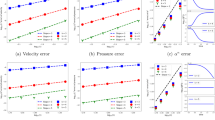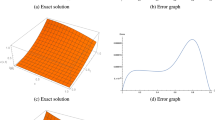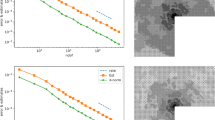Abstract
In this paper is discussed solving an elliptic equation and a boundary integral equation of the second kind by representation of compactly supported wavelets. By using wavelet bases and the Galerkin method for these equations, we obtain a stiff sparse matrix that can be ill-conditioned. Therefore, we have to introduce an operator which maps every sparse matrix to a circulant sparse matrix. This class of circulant matrices is a class of preconditioners in a Banach space. Based on having some properties in the spectral theory for this class of matrices, we conclude that the circulant matrices are a good class of preconditioners for solving these equations. We called them circulant wavelet preconditioners (CWP). Therefore, a class of algorithms is introduced for rapid numerical application.
Similar content being viewed by others
REFERENCES
R. Chan, Circulant preconditionersfor Hermitian Toeplitz systems, SIAM J. Matrix Anal. Appl. 10, 542–550 (1989).
D. Cohen, Partial Differential Equations: An Introduction, Random House, New York, 1998.
G. Beylkin, R. Coifman, and V. Rokhlin, Fast wavelet transforms and numerical analysis, J. Comm. Pure Appl. Math., 44, 141–193 (1992).
G. David, Wavelets andSingular Integral on Curves and Surface, Springer-Verlag, 1992.
P. Davis, Circulant Matrices, John Wiley and Sons, New York, 1979.
L. Elden, Algorithms forthe regularization of ill-conditioned least squares problems, BIT 17, 134–145 (1977).
A. Friedman, Variational Principles and Free-Boundary Problems, John Wiley & Sons, 1982.
G. Kaiser, A Friendly Guide to Wavelets, Birkhäuser, 1995.
M. A. Malcolm and J. Palmer, A fastmethod for solving a class of tridiagonal linear systems, Comm. ACM 17, 14–17 (1974).
Y. Meyer and R. Coifman, Wavelets Calderon-Zygmund and Multilinear Operators, Cambridge University Press, 1997.
Y. Meyer, Wavelets andOperators, Analysis at Urbana, Vol. 1, (E. Borkson, N. T. Peck, and J. Uhl, eds.) London Math. Society, Lecture Notes Series 137, 1989.
M. Mitrea, Clifford Wavelets Singular Integrals and Hard Spaces, Springer-Verlag, 1994.
B. S. Pariiski, An economical method for the numerical solution of convolution equations, USSR Comput. Math. and Math. Phy. 18, 208–211 (1978).
D. Rostami V. F. and K. Maleknejad, Fast iterative methods for solving of boundary nonlinear integral equations with singularity, J. Comp. Anal. and Appl. 1(2) 219–234 (1999).
D. Rostami V. F. and K. Maleknejad, Preconditioners for solving stochastic boundary integral equations with weakly singular kernels, Computing, 63, 47–67 (1999).
D. Rostami V. F., Preconditioned singular and hypersingular integral equations, PhD Thesis, Iran University of Science and Technology, 1999.
E. Tyrtyshnikov, Optimal andsuper optimal circulant preconditioners, SIAM J. Matrix Anal. Appl. 13, 459–473 (1992).
E. Tyrtyshnikov and V. V. Strela, Which circulant preconditioner is better? Math of Comp. 65, 135–150 (1996).
Y. Yan, Sparse preconditionediterative methods for dense linear systems, SIAM J. Sci. Comput. 15, 1190–1200 (1994).
Author information
Authors and Affiliations
Rights and permissions
About this article
Cite this article
Rostami Varnos Fadrani, D. Circulant Wavelet Preconditioners for Solving Elliptic Differential Equations and Boundary Integral Equations. Journal of Computational Analysis and Applications 5, 255–271 (2003). https://doi.org/10.1023/A:1022885129626
Issue Date:
DOI: https://doi.org/10.1023/A:1022885129626




